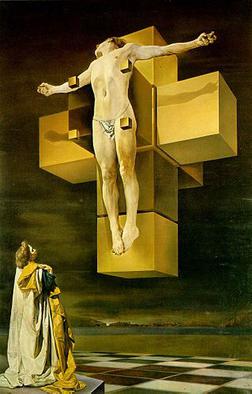In Australasia, the feast of the Exaltation of the Holy Cross is followed immediately by the feast of the Seven Sorrows of Mary. Australasia's celebration of the Seven Sorrows would coincide with the Feast of the Exaltation in other continents like Africa, Europe and North America.
This coincidence brought about by the convergence of geography and mathematics finds an artistic manifestation in Salvador Dali's famous painting Corpus Hypercubus, which he completed in 1954.
The use of the hypercubic cross, as the blogger
Keithpp, brings out interdimensional quality to the crucifixion, hinting at the transcendental aspects of this very historical act of execution. The materiality of the Passion of Christ is one that nonetheless unveils the "things hidden from the foundation of the world" (Matthew 13:35). Not only this, but the Marian figure (there is some suggestion that it can just as easily be Mary the Mother of God or Mary Magdalene) who witnesses the crucifixion is brought into a close proximity to this act of unveiling.
There are other reasons to account for the greatness of this piece of modern art, but for the moment, it might be a good idea to follow the lead of this Marian figure, and just gaze upon this work. Happy Feast of the Seven Sorrows/Exaltation of the Holy Cross to all.
Labels: art, Church and Culture, postsecular
